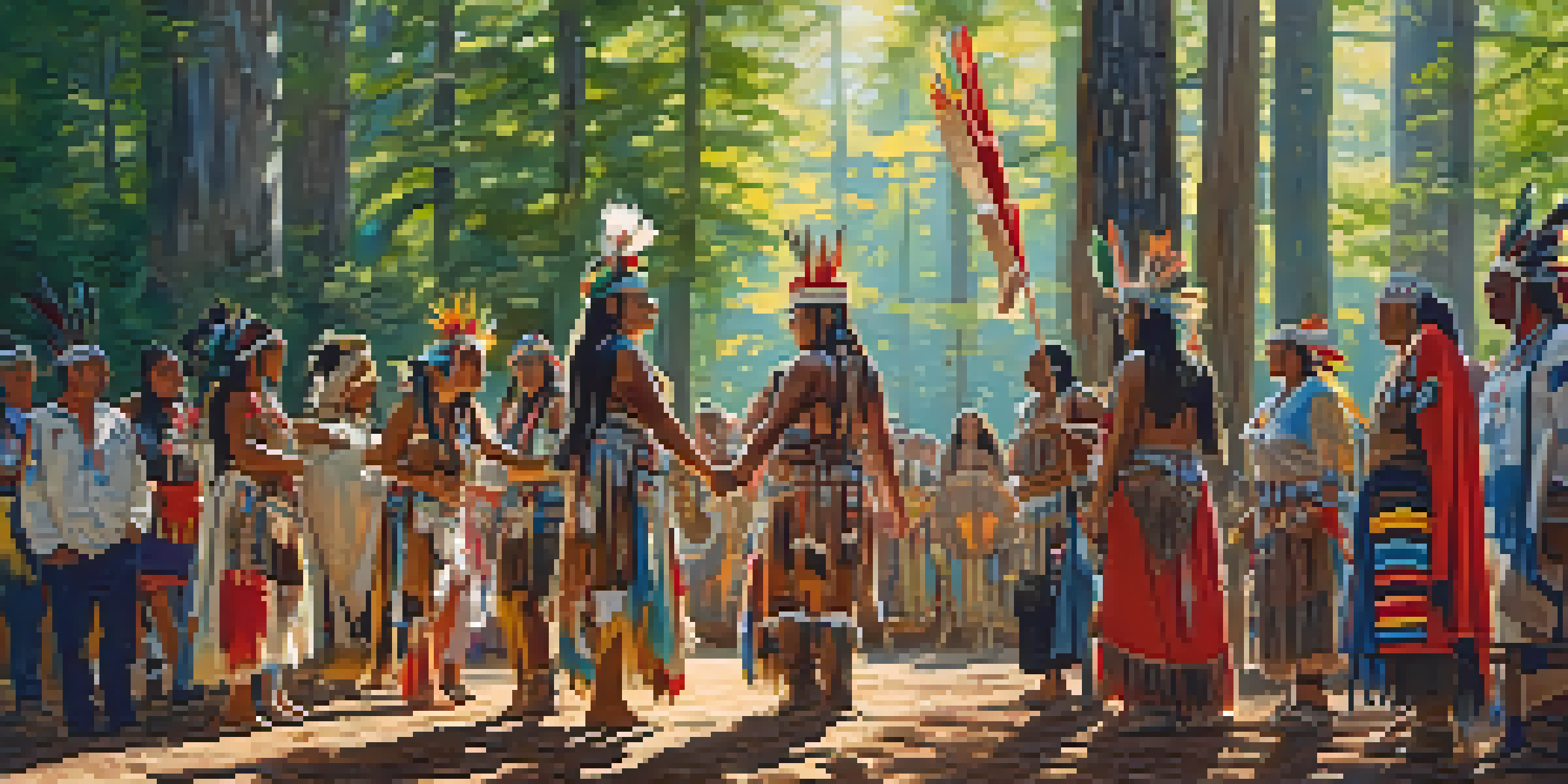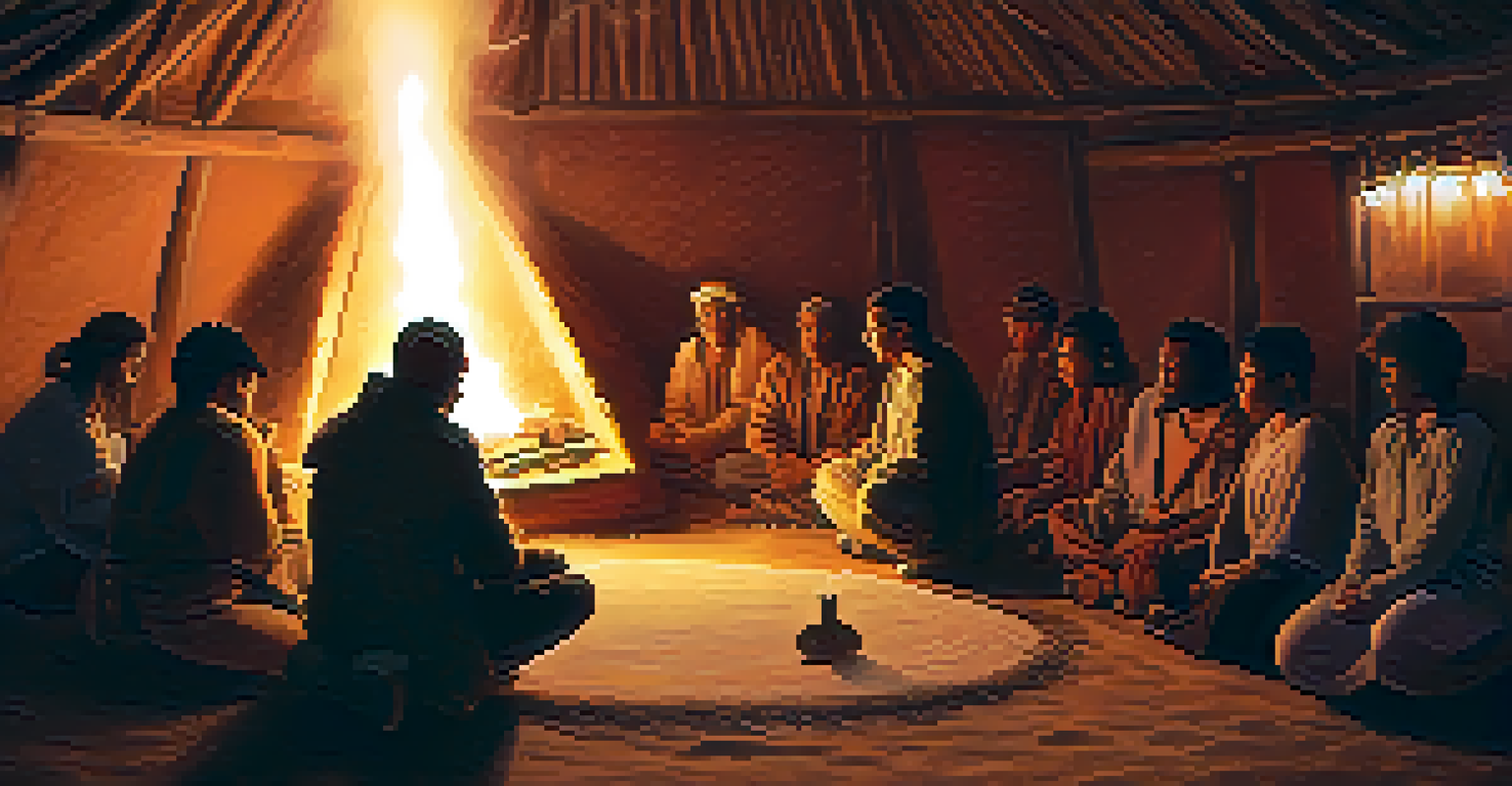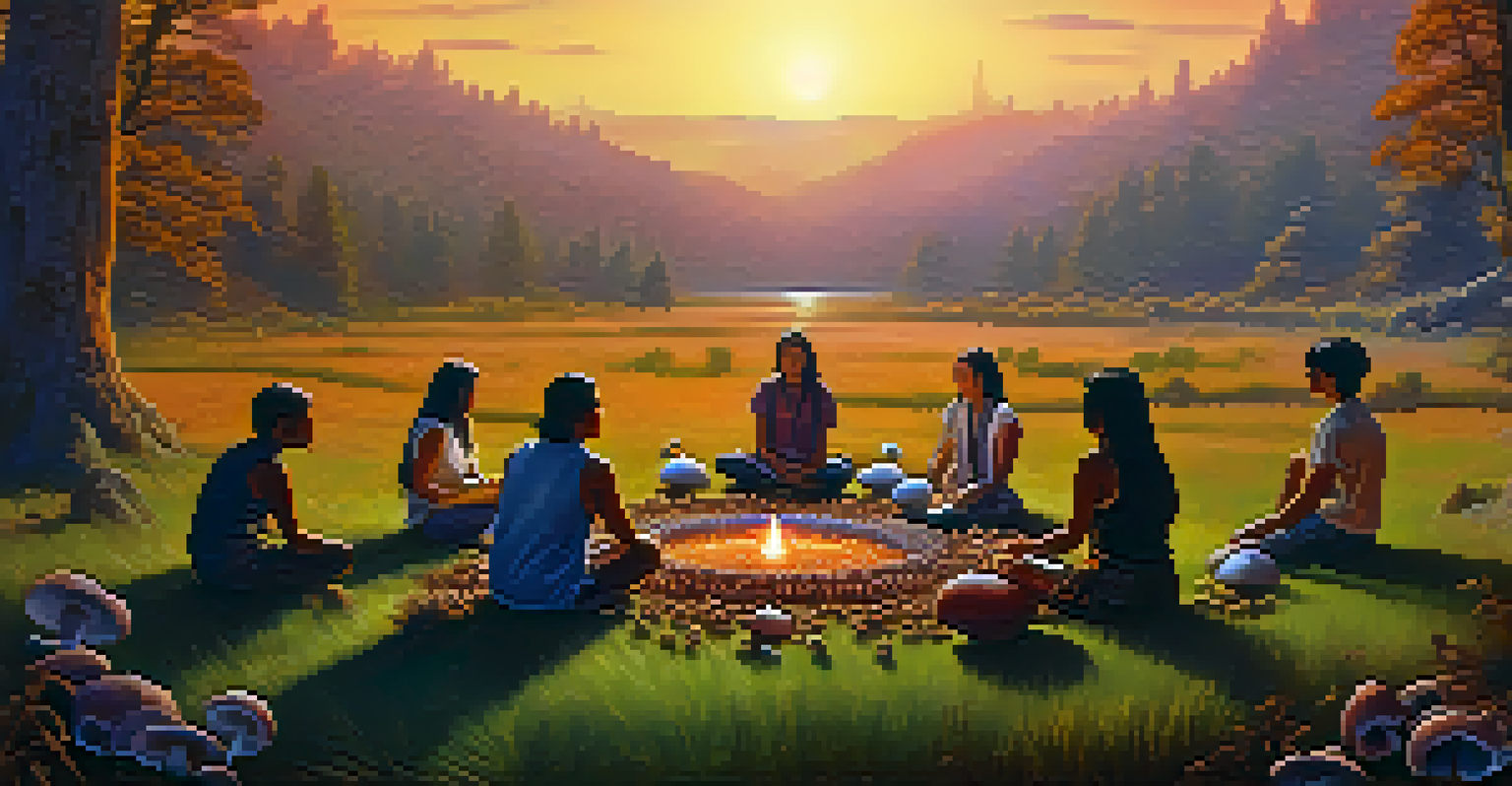Rituals and Entheogens: A Study of Indigenous Traditions

Understanding Rituals in Indigenous Cultures
Rituals are a fundamental aspect of many indigenous cultures, serving as a means to connect with the divine and the community. They often mark significant life events, seasonal changes, or spiritual journeys, providing a framework for societal values and beliefs. These ceremonies can range from simple gatherings to elaborate events, each steeped in tradition and meaning. Through rituals, indigenous peoples reinforce their identity and cultural heritage, creating a sense of belonging.
Rituals are the way we deal with the chaos of life.
For example, in many Native American cultures, the Sun Dance is a ritual that embodies healing and renewal. Participants engage in fasting, dancing, and other acts of devotion to seek a deeper connection with the Creator. Such rituals not only strengthen communal ties but also invoke a sense of purpose and understanding of one's place in the universe.
Moreover, rituals often serve as a medium for passing down knowledge from generation to generation. Elders share stories and teachings during these ceremonies, ensuring that important cultural narratives and practices are preserved. This transmission of knowledge is vital for maintaining the richness of indigenous cultures in an ever-changing world.
The Role of Entheogens in Spiritual Practices
Entheogens are substances, typically derived from plants, that have been used for centuries by various cultures to facilitate spiritual experiences. These substances are often ingested during rituals to induce altered states of consciousness, allowing individuals to explore deeper realms of existence. In many indigenous traditions, entheogens are viewed as sacred tools that connect the physical and spiritual realms, offering insights and healing.

For instance, the use of peyote in Native American spiritual practices illustrates how entheogens can play a significant role in communion with the divine. During ceremonies, participants consume peyote to enter visionary states, where they seek guidance, clarity, and healing. This not only enhances individual spirituality but also strengthens the community bond through shared experiences.
Rituals Connect Communities and Identity
Indigenous rituals serve to strengthen communal ties and reinforce cultural identity through shared spiritual practices.
It's important to note that the use of entheogens is often accompanied by specific rituals and guidance from knowledgeable leaders. This ensures that the experience is respectful, safe, and meaningful. When approached with reverence, entheogens can serve as catalysts for profound personal and collective transformation.
Historical Context of Indigenous Rituals and Entheogens
The use of rituals and entheogens among indigenous cultures can be traced back thousands of years, with evidence found in archaeological sites worldwide. These practices are often deeply intertwined with the natural environment, reflecting the relationship between people and the land. Indigenous groups have traditionally viewed themselves as stewards of the Earth, and their rituals often honor and celebrate this connection.
The earth does not belong to us; we belong to the earth.
For example, the ancient Mazatec people of Mexico have long utilized psilocybin mushrooms in their ceremonies, a practice that dates back at least 500 years. These rituals not only serve spiritual purposes but also promote ecological awareness and respect for the natural world. This blend of spirituality and environmental stewardship is a hallmark of many indigenous practices.
Understanding the historical context of these rituals is crucial, especially as modern society grapples with issues like climate change and cultural erasure. By learning from indigenous traditions, contemporary societies can glean valuable insights into sustainability and holistic living, fostering a more respectful relationship with the planet.
Contemporary Practices of Rituals and Entheogens
In recent years, there has been a resurgence of interest in indigenous rituals and the use of entheogens, particularly among those seeking alternative spiritual paths. Many people are drawn to these practices for their perceived healing properties and opportunities for personal growth. However, this revival raises important questions about cultural appropriation and the ethical use of sacred traditions.
For instance, retreats and workshops focused on ayahuasca ceremonies have gained popularity in Western cultures. While participants often seek transformation and healing, it is essential to approach these experiences with respect for the indigenous peoples who have historically practiced them. Engaging with these traditions requires an understanding of their cultural significance, as well as a commitment to supporting the communities that have preserved them.
Entheogens Facilitate Spiritual Growth
Entheogens are sacred tools in rituals that help individuals achieve altered states of consciousness for deeper spiritual exploration.
This contemporary interest can also serve as a platform for indigenous voices to be amplified and respected. By fostering respectful dialogue and collaboration, there is potential for mutual learning and appreciation. This not only honors the origins of these practices but also contributes to the revitalization of indigenous cultures in the modern world.
The Impact of Colonialism on Indigenous Rituals
Colonialism has had a profound and often devastating impact on indigenous cultures, including their rituals and practices involving entheogens. Many indigenous societies faced suppression of their spiritual practices and were forced to abandon their traditional ways of life. This loss not only affected their cultural identity but also disrupted the transmission of knowledge and customs critical to their survival.
For example, in North America, the Indian Act of 1876 imposed restrictions on indigenous ceremonies, effectively criminalizing practices integral to their identity. The outlawing of these rituals led to a disconnection from cultural heritage, as generations were unable to participate in or learn about their traditions. This historical trauma continues to resonate within indigenous communities today.
Despite these challenges, many indigenous groups are actively working to reclaim their rituals and restore their cultural practices. This resurgence is a powerful testament to resilience and the enduring significance of rituals in preserving identity and community. By recognizing the ongoing effects of colonialism, we can better understand the importance of supporting indigenous efforts to revitalize their traditions.
Healing and Community through Rituals
Rituals serve as a powerful vehicle for healing within indigenous communities, providing a space for collective support and understanding. Often, these ceremonies address not only individual traumas but also the broader wounds experienced by the community, such as those inflicted by colonization or loss. Through shared experiences, participants can find solace and connection, fostering a sense of unity and healing.
Take, for instance, the use of sweat lodges among various indigenous cultures. These purification ceremonies involve a gathering in a small, darkened space where participants engage in prayer, singing, and sharing stories. The process offers both physical cleansing and spiritual renewal, creating a supportive environment where individuals can confront and heal from personal and communal challenges.
Colonialism Disrupted Indigenous Practices
The impact of colonialism has led to the suppression of indigenous rituals, but many communities are now working to reclaim and revitalize these traditions.
Moreover, the communal aspect of rituals reinforces social bonds and encourages collective resilience. As individuals come together to participate in these practices, they affirm their shared identity and commitment to supporting one another. This sense of belonging is vital in promoting mental and emotional well-being, especially in the face of societal pressures and adversities.
Respecting Cultural Heritage and Future Directions
As interest in indigenous rituals and entheogens grows, it is crucial to approach these practices with respect and sensitivity. Understanding the cultural significance and historical context of these traditions is essential for anyone looking to engage with them. This means listening to indigenous voices, supporting their rights, and advocating for the protection of their cultural heritage.
One way to honor these traditions is by promoting ethical tourism and responsible engagement with indigenous communities. This involves educating oneself about their practices and seeking permission and guidance when participating in rituals. By doing so, individuals can contribute to the sustainability of these traditions and the empowerment of indigenous peoples.

Looking ahead, the future of indigenous rituals and entheogens lies in the balance of preservation and adaptation. As these practices continue to evolve, it is vital to ensure that they remain rooted in their cultural significance while also allowing for contemporary interpretations. By fostering respectful relationships and open dialogue, we can support the flourishing of indigenous cultures and the revitalization of their sacred traditions.